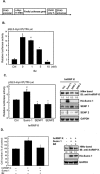Bortezomib inhibits Burkitt's lymphoma cell proliferation by downregulating sumoylated hnRNP K and c-Myc expression
- PMID: 26317903
- PMCID: PMC4694880
- DOI: 10.18632/oncotarget.4620
Bortezomib inhibits Burkitt's lymphoma cell proliferation by downregulating sumoylated hnRNP K and c-Myc expression
Abstract
Bortezomib (Velcal) was the first proteasome inhibitor to be approved by the US Food and Drug Administration to treat patients with relapsed/refractory multiple myelomas. Previous studies have demonstrated that bortezomib inhibits tumor cell proliferation and induces apoptosis by blocking the nuclear factor (NF)-κB pathway. However, the exact mechanism by which bortezomib induces cancer cell apoptosis is still not well understood. In this study, we found that bortezomib significantly inhibited cell proliferation in both human Burkitt's lymphoma CA46 and Daudi cells. Through proteomic analysis, we found that bortezomib treatment changed the expression of various proteins in distinct functional categories including unfolding protein response (UPS), RNA processing, protein targeting and biosynthesis, apoptosis, and signal transduction. Among the proteins with altered expression, hnRNP K, hnRNP H, Hsp90α, Grp78, and Hsp7C were common to both Daudi and CA46 cells. Interestingly, bortezomib treatment downregulated the expression of high-molecular-weight (HMw) hnRNP K and c-Myc but upregulated the expression of low-molecular-weight (LMw) hnRNP K. Moreover, cell proliferation was significantly correlated with high expression of HMw hnRNP K and c-Myc. HMw and LMw hnRNP K were identified as sumoylated and desumoylated hnRNP K, respectively. Using transient transfection, we found that sumoylated hnRNP K increased c-Myc expression at the translational level and contributed to cell proliferation, and that Lys422 of hnRNP K is the candidate sumoylated residue. Our results suggest that besides inhibiting the ubiquitin-proteasome pathway, bortezomib may inhibit cell proliferation by downregulating sumoylated hnRNP K and c-Myc expression in Burkitt's lymphoma cells.
Keywords: Bortezomib; Burkitt’s lymphoma; c-Myc; hnRNP K; sumoylation.
Conflict of interest statement
None.
Figures








Similar articles
-
Cationic lipids reduce time and dose of c-myc antisense oligodeoxynucleotides required to specifically inhibit Burkitt's lymphoma cell growth.Leukemia. 1996 Dec;10(12):1980-9. Leukemia. 1996. PMID: 8946941
-
Syntheses and evaluation of new Quinoline derivatives for inhibition of hnRNP K in regulating oncogene c-myc transcription.Bioorg Chem. 2019 Apr;85:1-17. doi: 10.1016/j.bioorg.2018.12.020. Epub 2018 Dec 22. Bioorg Chem. 2019. PMID: 30599408
-
Iron specific growth inhibition of Burkitt's lymphoma cells in vitro, associated with a decrease in translocated c-myc expression.J Cell Physiol. 2005 Apr;203(1):277-85. doi: 10.1002/jcp.20229. J Cell Physiol. 2005. PMID: 15468060
-
Emerging molecular networks in Burkitt's lymphoma.J Cell Biochem. 2013 Jan;114(1):35-8. doi: 10.1002/jcb.24358. J Cell Biochem. 2013. PMID: 22903691 Review.
-
The Eµ-hnRNP K Murine Model of Lymphoma: Novel Insights into the Role of hnRNP K in B-Cell Malignancies.Front Immunol. 2021 Apr 12;12:634584. doi: 10.3389/fimmu.2021.634584. eCollection 2021. Front Immunol. 2021. PMID: 33912162 Free PMC article. Review.
Cited by
-
Hypoxia-induced alternative splicing: the 11th Hallmark of Cancer.J Exp Clin Cancer Res. 2020 Jun 15;39(1):110. doi: 10.1186/s13046-020-01616-9. J Exp Clin Cancer Res. 2020. PMID: 32536347 Free PMC article. Review.
-
Emerging roles of Myc in stem cell biology and novel tumor therapies.J Exp Clin Cancer Res. 2018 Jul 27;37(1):173. doi: 10.1186/s13046-018-0835-y. J Exp Clin Cancer Res. 2018. PMID: 30053872 Free PMC article. Review.
-
Combination of Everolimus and Bortezomib Inhibits the Growth and Metastasis of Bone and Soft Tissue Sarcomas via JNK/p38/ERK MAPK and AKT Pathways.Cancers (Basel). 2023 Apr 26;15(9):2468. doi: 10.3390/cancers15092468. Cancers (Basel). 2023. PMID: 37173935 Free PMC article.
-
BI6727, a polo-like kinase 1 inhibitor with promising efficacy on Burkitt lymphoma cells.J Int Med Res. 2020 May;48(5):300060520926093. doi: 10.1177/0300060520926093. J Int Med Res. 2020. PMID: 32468878 Free PMC article.
-
Post-translational modification control of RNA-binding protein hnRNPK function.Open Biol. 2019 Mar 29;9(3):180239. doi: 10.1098/rsob.180239. Open Biol. 2019. PMID: 30836866 Free PMC article. Review.
References
-
- Hamrick-Turner JE, Saif MF, Powers CI, Blumenthal BI, Royal SA, Iyer RV. Imaging of childhood non-Hodgkin lymphoma: assessment by histologic subtype. Radiographics. 1994;14:11–28. - PubMed
-
- Magrath I. Epidemiology: clues to the pathogenesis of Burkitt lymphoma. Brit J Haematol. 2012;156:744–756. - PubMed
-
- Molyneux EM, Rochford R, Griffin B, Newton R, Jackson G, Menon G, Harrison CJ, Israels T, Bailey S. Burkitt's lymphoma. Lancet. 2012;379:1234–1244. - PubMed
-
- Tomita N. BCL2 and MYC dual-hit lymphoma/leukemia. J Clin Exp Hematop. 2011;51:7–12. - PubMed
-
- Kenkre VP, Stock W. Burkitt lymphoma/leukemia: improving prognosis. Clin Lymphoma Myeloma. 2009;9:S231–S238. - PubMed
Publication types
MeSH terms
Substances
LinkOut - more resources
Full Text Sources
Other Literature Sources
Research Materials
Miscellaneous

